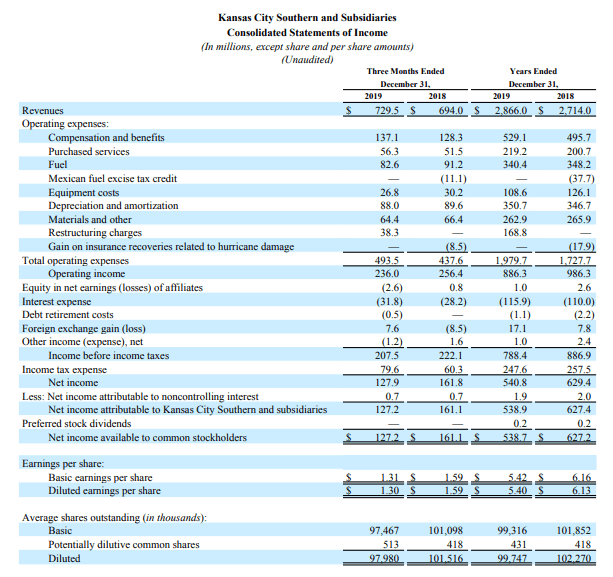Kansas City Southern (NYSE: KSU) expects rail volumes and revenue to grow in 2020 amid service improvements and clarity on U.S. trade policy concerning North America.
“I think the headline for our outlook for 2020 is that we expect it to be better than 2019 in terms of volume and revenue,” said Kansas City Southern (KCS) CEO Pat Ottensmeyer during his company’s fourth-quarter earnings call on Friday.
Ottensmeyer also said later in the call that the resolution of the free trade agreement between the U.S., Mexico and Canada is “a positive” because it provides clarity to all three countries.
KCS provided its guidance for the year, which includes low-single-digit volume growth and mid-single-digit revenue growth, as well as an operating ratio of 60-61% in 2020 and below 60% in 2021. Operating ratio in 2019 was 69.1%, although adjusted operating ratio was 63.2%.
KCS calculates operating ratio — a measure of a company’s financial health — by dividing operating expenses by revenue. The adjusted figure divides adjusted operating expenses by revenue.
KCS also plans for capital expenditures to be around 17% of revenue through 2022, compared with previous guidance of around 18% of revenue through 2021.
The railroad is well underway with its deployment of precision scheduled railroading (PSR), an operating model that seeks to streamline operations. The productivity measures are aimed not only at U.S. operations but at KCS’ operations in Mexico.
Among the PSR-related goals for 2020 are less classification events, with a higher percentage of events occuring at KCS’ larger rail yards; an emphasis on low horsepower-to-tonnage ratio to improve fuel efficiency; more asset takeout and crew reductions; an increased use of maintenance of way employees; new service redesign initiatives in the U.S.; and streamlined border operations, according to Sameh Fahmy, KCS’ executive vice president for PSR.
“We’re putting a lot of focus on crew management,” Fahmy said.
Fahmy said the productivity-related results in the fourth quarter of 2019 compared with the same period in 2018 have included a 7% decline in crew starts in Mexico and a 5% improvement in fuel efficiency. The active locomotive fleet declined 16% from its peak in the fourth quarter of 2018.
Fourth-quarter results
Net profit for KCS slipped in the fourth quarter of 2019 compared to the prior year, but revenues were 5% higher amid increases for chemicals and petroleum and industrial and consumer products.
Fourth-quarter net income was $127.2 million, or $1.30 diluted earnings per share, compared with $161.1 million, or $1.59 diluted earnings per share, in the fourth quarter of 2018, the company said Friday.

Revenue in the fourth quarter totaled $729.5 million amid a 13% increase in chemicals and petroleum and an 11% increase in industrial and consumer products compared with the fourth quarter of 2018, KCS said. Automotive and intermodal volumes dragged overall carload volumes down by 1% in the fourth quarter.
Operating expenses were also higher, due in part to $38.3 million in costs because of restructuring charges related to KCS’ implementation of PSR in 2019. Fourth-quarter operating expenses were $493.5 million, compared with $437.6 million in the fourth quarter of 2018.
Operating income in the fourth quarter was $236 million, compared with $256.4 million in the prior year. Operating ratio was 67.6%, compared with 63.1% in the fourth quarter of 2018.

Service metrics improved in the fourth quarter, with average train speed of 15.2 miles per hour, compared with 11.2 mph in the fourth quarter of 2018, and average terminal dwell at 19.9 hours, versus 26 hours in the prior-year period. Terminal dwell is how long a train sits at a terminal.

| Rail | 2019 Value | 2018 Value | Y/Y Gross Change | Y/Y % Change |
| Freight revenue (in millions) | $729.5 | $694.0 | $35.5 | 5.1% |
| Carloads (000s) | 65 | 63 | 1 | 1.7% |
| Revenue per carload | $972 | $1,030 | -$58 | -5.6% |
| Intermodal shipments | 254 | 268 | -14 | -5.3% |
| Intermodal revenue per carload | $383 | $366 | $17 | 4.6% |
| Gross ton miles (in millions) | 25,745.0 | 25,031.0 | 714 | 2.9% |
| Train velocity (mph) | 15.2 | 11.2 | 4 | 35.7% |
| Dwell time (hours) | 19.9 | 26 | -6 | -23.5% |
| OR% | 67.6% | 63.1% | 4.5% | 7.1% |
| Diluted EPS | $1.30 | $1.59 | -$0.29 | -18.2% |







